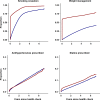Health checks and cardiovascular risk factor values over six years' follow-up: Matched cohort study using electronic health records in England
- PMID: 31361740
- PMCID: PMC6667114
- DOI: 10.1371/journal.pmed.1002863
Health checks and cardiovascular risk factor values over six years' follow-up: Matched cohort study using electronic health records in England
Abstract
Background: The National Health Service (NHS) in England introduced a population-wide programme for cardiovascular disease (CVD) prevention in 2009, known as NHS Health Checks. This research aimed to measure the cardiovascular risk management and cardiovascular risk factor outcomes of the health check programme during six years' follow-up.
Methods and findings: A controlled interrupted time series study was conducted. Participants were registered with general practices in the Clinical Practice Research Datalink (CPRD) in England and received health checks between 1 April 2010 and 31 December 2013. Control participants, who did not receive a health check, were matched for age, sex, and general practice. Outcomes were blood pressure, body mass index (BMI), smoking, and total cholesterol (TC) and high-density lipoprotein cholesterol (HDL). Analyses estimated the net effect of health check by year, allowing for the underlying trend in risk factor values and baseline differences between cases and controls, adjusting for age, sex, deprivation, and clustering by general practice. There were 127,891 health check participants and 322,910 matched controls. Compared with controls, health check participants had lower BMI (cases mean 27.0, SD 4.8; controls 27.3, SD 5.6, Kg/m2), systolic blood pressure (SBP) (cases 129.0, SD 14.3; controls 129.3, SD 15.0, mm Hg), and smoking (21% in health check participants versus 27% in controls), but total and HDL cholesterol were similar. Health check participants were more likely to receive weight management advice (adjusted hazard ratio [HR] 5.03, 4.98 to 5.08, P < 0.001), smoking cessation interventions (HR 3.20, 3.13 to 3.27, P < 0.001), or statins (HR 1.24, 1.21 to 1.27, P < 0.001). There were net reductions in risk factor values up to six years after the check for BMI (-0.30, -0.39 to -0.20 Kg/m2, P < 0.001), SBP (-1.43, -1.70 to -1.16 mm Hg, P < 0.001), and smoking (17% in health check participants versus 25% in controls; odds ratio 0.90, 0.87 to 0.94, P < 0.001). The main study limitation was that residual confounding may be present because randomisation was not employed; health check-associated measurement introduced differential recording that might cause bias.
Conclusions: Our results suggest that people who take up a health check generally have lower risk factor values than controls and are more likely to receive risk factor interventions. Risk factor values show net reductions up to six years following a health check in BMI, blood pressure, and smoking, which may be of public health importance.
Conflict of interest statement
The authors have declared that no competing interests exist.
Figures



Similar articles
-
Do health checks improve risk factor detection in primary care? Matched cohort study using electronic health records.J Public Health (Oxf). 2016 Sep;38(3):552-559. doi: 10.1093/pubmed/fdv119. Epub 2015 Sep 7. J Public Health (Oxf). 2016. PMID: 26350481 Free PMC article.
-
The current and potential health benefits of the National Health Service Health Check cardiovascular disease prevention programme in England: A microsimulation study.PLoS Med. 2018 Mar 6;15(3):e1002517. doi: 10.1371/journal.pmed.1002517. eCollection 2018 Mar. PLoS Med. 2018. PMID: 29509767 Free PMC article.
-
Estimating the yield of NHS Health Checks in England: a population-based cohort study.J Public Health (Oxf). 2015 Jun;37(2):234-40. doi: 10.1093/pubmed/fdu079. Epub 2014 Oct 17. J Public Health (Oxf). 2015. PMID: 25326192 Free PMC article.
-
General Health Checks in Adult Primary Care: A Review.JAMA. 2021 Jun 8;325(22):2294-2306. doi: 10.1001/jama.2021.6524. JAMA. 2021. PMID: 34100866 Review.
-
An evaluation of the effectiveness of annual health checks and quality of health care for adults with intellectual disability: an observational study using a primary care database.Southampton (UK): NIHR Journals Library; 2017 Sep. Southampton (UK): NIHR Journals Library; 2017 Sep. PMID: 28930382 Free Books & Documents. Review.
Cited by
-
Characteristics and health-status outcomes in patients with atrial fibrillation detected via health screening.Clin Cardiol. 2023 Jan;46(1):32-40. doi: 10.1002/clc.23932. Epub 2022 Oct 27. Clin Cardiol. 2023. PMID: 36300885 Free PMC article.
-
Incremental prognostic value of arterial elastance in mild-to-moderate idiopathic pulmonary fibrosis.Int J Cardiovasc Imaging. 2022 Jul;38(7):1473-1485. doi: 10.1007/s10554-022-02541-y. Epub 2022 Feb 1. Int J Cardiovasc Imaging. 2022. PMID: 35103898
-
NHS Health Checks: an observational study of equity and outcomes 2009-2017.Br J Gen Pract. 2021 Aug 26;71(710):e701-e710. doi: 10.3399/BJGP.2020.1021. Print 2021 Sep. Br J Gen Pract. 2021. PMID: 33587723 Free PMC article.
-
Strategies to improve the implementation of preventive care in primary care: a systematic review and meta-analysis.BMC Med. 2024 Sep 27;22(1):412. doi: 10.1186/s12916-024-03588-5. BMC Med. 2024. PMID: 39334345 Free PMC article.
-
Age Influences on Lifestyle and Stress Perception in the Working Population.Nutrients. 2023 Jan 12;15(2):399. doi: 10.3390/nu15020399. Nutrients. 2023. PMID: 36678269 Free PMC article.
References
-
- BHF. Heart Statistics 2017. Available from: https://www.bhf.org.uk/research/heart-statistics. Cited 02 February 2018.
-
- CDC. Heart Disease Facts 2017. Available from: https://www.cdc.gov/heartdisease/facts.htm. Cited 02 February 2018.
-
- WHO. Global Heath Risks: Mortality and burden of disease attributable to selected major risks 2009. Available from: http://www.who.int/healthinfo/global_burden_disease/GlobalHealthRisks_re.... Cited 26 January 2018.
Publication types
MeSH terms
Substances
Grants and funding
LinkOut - more resources
Full Text Sources
Miscellaneous

